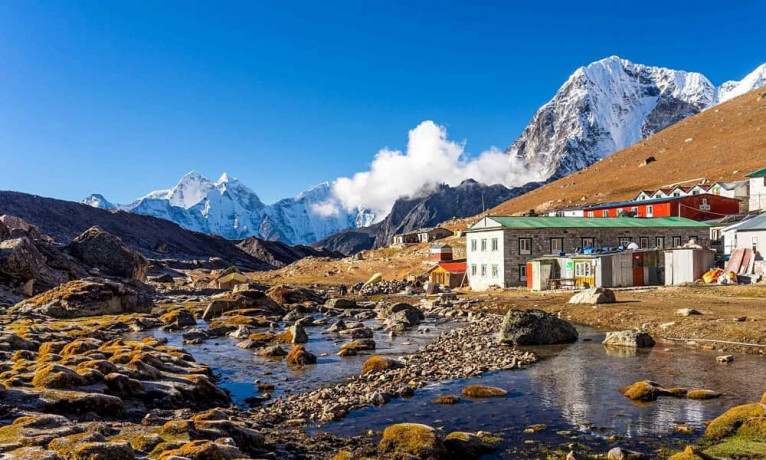Lobuche: The Gateway to Everest's Majesty Professional
Jul 9th, 2024 at 13:40 Blogs Lobuche 250 views Reference: 1382Location: Lobuche
Price: Contact us
Lobuche: The Gateway to Everest's Majesty
Lobuche, a picturesque village nestled in the Khumbu region of Nepal, is a key stop on the iconic trek to Everest Base Camp (EBC). Located at an altitude of approximately 4,940 meters (16,210 feet), Lobuche offers trekkers breathtaking views of the Himalayan giants and serves as a critical acclimatization point on their journey to the world's highest peak.
Historical Background
Lobuche, like many other settlements in the Khumbu region, has evolved primarily due to the growing popularity of trekking and mountaineering. The village has a long history intertwined with the legendary Sherpa culture. The Sherpas, known for their exceptional mountaineering skills and deep spiritual connection to the Himalayas, have been integral to the exploration and climbing of Mount Everest and other peaks in the region.
Geographical Significance
Situated in the Solu-Khumbu District of Province No. 1, Lobuche lies on the route to the Everest Base Camp and is a common stopping point for acclimatization. The village is surrounded by some of the most iconic peaks in the world, including Lobuche East and West, Pumori, and Nuptse. Its location makes it an ideal vantage point for trekkers to rest, acclimate, and soak in the stunning vistas of the Himalayas.
Trekking to Lobuche
The trek to Lobuche is part of the classic Everest Base Camp trek, which typically starts from Lukla. After landing at the Lukla airport, trekkers pass through several key stops, including Namche Bazaar, Tengboche, Dingboche, and ultimately Lobuche.
1. Namche Bazaar
Namche Bazaar, the bustling hub of the Khumbu region, is the first major acclimatization stop. Trekkers can explore local markets, visit the Sherpa Museum, and enjoy the stunning views of Ama Dablam, Everest, and Lhotse.
2. Tengboche
Home to the famous Tengboche Monastery, this village offers a serene environment and a chance to experience the spiritual side of the Himalayas. The monastery, set against the backdrop of the towering Ama Dablam, is a highlight for many trekkers.
3. Dingboche
Dingboche is another key acclimatization stop, offering trekkers a chance to adjust to the increasing altitude. The village provides magnificent views of the Imja Valley and the surrounding peaks.
4. Lobuche
Reaching Lobuche involves a challenging hike, but the rewards are immense. The village is perched on the side of a steep valley and provides stunning views of the Khumbu Glacier and the surrounding mountains.
Acclimatization and Health
Acclimatization is crucial when trekking to high altitudes, and Lobuche serves as an important point for this process. Trekkers often spend an extra day here to adjust to the thin air and lower oxygen levels. It is essential to monitor for symptoms of altitude sickness, which can include headaches, nausea, and dizziness. Adequate hydration, rest, and gradual ascent are key strategies to ensure a safe trek.
Cultural Encounters
Lobuche and the surrounding Khumbu region are rich in Sherpa culture. Trekkers have the opportunity to interact with the local Sherpa community, known for their hospitality, resilience, and deep-rooted Buddhist traditions. Visiting monasteries, participating in local ceremonies, and learning about Sherpa customs add a rich cultural dimension to the trekking experience.
Natural Beauty and Photography
Lobuche is a paradise for nature lovers and photographers. The village offers unobstructed views of some of the world's highest peaks. The nearby Khumbu Glacier, with its dramatic ice formations and deep crevasses, is a highlight for many trekkers. Sunrise and sunset over the Himalayas from Lobuche are particularly spectacular, with the mountains bathed in golden light.
Preparation and Logistics
Trekking to Lobuche requires thorough preparation and logistical planning. Key considerations include:
- Physical Fitness: A good level of fitness is essential, as the trek involves long days of walking and steep ascents.
- Proper Gear: Adequate clothing and equipment for cold weather, including layered clothing, a down jacket, sturdy trekking boots, and a good-quality sleeping bag, are crucial.
- Permits: Trekkers need to obtain necessary permits, including the Sagarmatha National Park permit and the Khumbu Pasang Lhamu Rural Municipality permit.
- Guides and Porters: Hiring experienced guides and porters can enhance safety and make the trek more enjoyable.
Conclusion
Lobuche, with its stunning natural beauty and strategic location, is an essential stop on the Everest Base Camp trek. The village offers trekkers a chance to acclimate, experience Sherpa culture, and marvel at the breathtaking vistas of the Himalayas. As more adventurers seek to conquer Everest and explore the Khumbu region, Lobuche continues to be a vital and unforgettable part of their journey.


